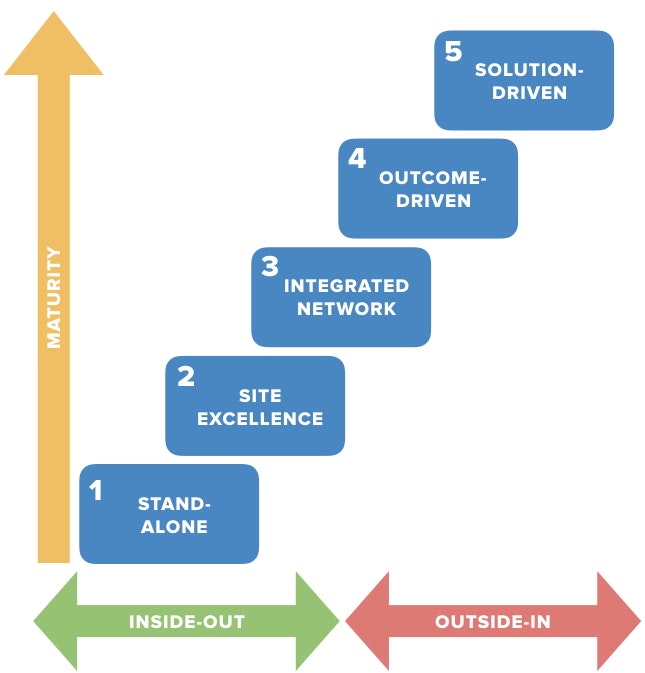Why You Must Know Your Maturity Level for Real Manufacturing Improvements
Despite the prevailing common wisdom, maturity is not overrated.
Maturity is the process of meeting current and future responsibilities—for manufacturers, the maturity of your production process and every aspect that impacts it is what gives you an advantage or puts you far behind competitors. Manufacturing excellence is the goal.
Manufacturers that can’t gauge their maturity and don’t take steps to improve will fall behind competitors in adaptability and innovation.
How do you gauge your own business? Using Gartner’s Five Stages of Manufacturing Maturity (content available to Gartner clients), we’ll help you determine your maturity level and explain how to move to the next stage in a systematic way.
The Five Stages of Manufacturing Maturity
Gartner defines five distinct stages of maturity for manufacturers based on their goals, processes, organizational structure, performance management capabilities and technology.
As companies mature, improvements in production move from internal, isolated processes to impact the entire supply chain.
Gartner’s Maturity Model for Manufacturing Excellence

Why does this model matter to small and midsize manufacturers?
Emerging technology trends—including the Internet of Things, AI and smart manufacturing—will impact manufacturers large and small. Recognizing your production maturity helps you reach the next level of sophistication and remain competitive.
Stage 1: Stand-alone manufacturing
This stage is characterized by a manufacturing process isolated from the rest of the supply chain. These organizations regularly react to sudden problems in demand and materials.
Signs you’re in Stage 1:
Your team reacts to problems with solutions made on the spot.
Your processes for production, maintenance and improvements are largely undocumented or standardized.
You have too much unplanned machine downtime that impacts production.
How to move to Stage 2:
Consult with experts in lean manufacturing and continuous improvement projects to identify and remove poor practices, and simplify effective ones.
Commit to replacing repetitive, manual tasks with automation.
Stage 2: Site excellence
This refers to manufacturers who recognize that costs and complexity in production must be eliminated, and who develop best practices to increase efficiency.
Signs you’re in Stage 2:
Your team follows documented and controlled processes designed from improvement projects.
You established standardized best practices based on lessons learned during improvement projects.
You’ve automated parts of production in ways that save time and money and increase safety.
How to move to Stage 3:
Determine the specific best practices that should be standardized across all sites without hampering the specialization of each site.
Establish a schedule for ongoing analysis of production data to identify other areas for improvement or automation.
Stage 3: Integrated networks
Integrated networks are common to manufacturers who operate on a platform of overarching processes, which are standardized for all sites and continuously improved upon.
Signs you’re in Stage 3:
You have standardized best practices used consistently at multiple sites with the assistance of a end-to-end system (such as an ERP).
Your processes take into account different levels of agility and specializations among sites.
Automation at your plants goes beyond production to other related tasks, but unplanned problems are still managed manually.
How to move to Stage 4:
Identify every point in your supply chain and develop expectations about costs and delivery times.
Map the capabilities and capacity for each site to optimize scheduling and specialized production functions.
Stage 4: Outcome-driven
These manufacturers connect their production process with all other parts of the supply chain to drive common outcomes.
Signs you’re in Stage 4:
Your best practices are codified into an company-wide system that integrates all the providers along the supply chain.
You use strategies to optimize costs and optimize scheduling to meet production demand, from the initial order to delivery.
You outsource some parts of your production to trusted third-parties to save costs and increase quality.
How to move to Stage 5:
Leverage technology that analyzes data and offers self-adaptability or prescriptive advice.
Prioritize innovation by working with other organizations in your supply chain to create new competitive advantages.
Stage 5: Solution-driven
In this stage, manufacturing carries value (and risk) from the production process to all other areas of a company. This helps businesses respond to demand and market conditions with greater flexibility.
Signs you’re in Stage 5
The ways you create and fulfill demand has an impact on allocating capacity and resources among production sites.
Your processes are digitized in a system and we analyze production data to improve and innovate.
Production processes can self-adapt and reconfigure as conditions change.
Stages 1-3 represent mostly internal challenges, while Stages 4 and 5 begin to consider and improve external conditions and third-party contributions to the overall production goal.
What Else Do I Need to Mature?
Many of the manufacturers who reach out to Software Advice are smaller operations looking to introduce more automation to leverage data and maintain best practices. For these companies in Stages 1 or 2, the most impactful actions to take include:
Working with lean manufacturing experts to create an improvement roadmap.
Identifying the most effective local best practices and standardizing them across all production sites.
Adopting a manufacturing resource planning (MRP) system or enterprise resource planning (ERP) system to collect and use data and codify best practices.
If you need more help to determine your maturity level, email me at taylorshort@softwareadvice.com. If you’re ready to use technology to mature, call our software advisors at (844) 680-2046 for a free consultation to find the best manufacturing system for your plant.